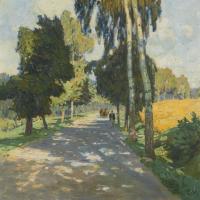Carl Moll (1861-1945)
Carl Julius Rudolf Moll (23 April 1861 – 13 April 1945) was a prominent art nouveau painter active in Vienna at the start of the 20th century. He was one of the artists of the Vienna Secession who took inspiration from the pointillist techniques of French Impressionists.
Moll was born in Vienna, Austria. He studied art at the Academy of Fine Arts Vienna. He was a student of Christian Griepenkerl and of Emil Jakob Schindler (the father of Alma Mahler-Werfelnée Schindler). After his teacher's death (1892), Moll married Schindler's widow, Anna (née von Bergen).
Moll was a founder-member of the Vienna Secession in 1897 and, in 1903 encouraged the use of the Belvedere Gallery to show exhibitions of modern Austrian art. In 1905 he, along with Gustav Klimt, left the Secession, although Moll continued to be involved with the exhibition of art in Vienna including the first exhibition in Vienna of the work of Vincent van Gogh(the second painting above the sideboard in his 1906 self-portrait is Van Gogh's Portrait of the Artist's Mother). His paintings are characterized by the use of pointillist techniques within a strict organization of the surface of the painting.
He committed suicide at the end of World War II, in Vienna.
On 21 June 2013, the online auction house Auctionata in Berlin sold Moll's Villa in Vienna for 240,000 Euros. Previously a smaller painting, a still-life entitled Speisezimmer I, from the Rau collection fetched 286,700 Euros at Lempertz, a world record price for the artist.
The viennese auction house Dorotheum sold his painting "Blick auf Nussdorf und Heiligenstadt in der Dämmerung" for 228,839 Euros on 27 November 2007.
In 2018, the National Gallery of Canada acquired the 1901 work At the lunch table, previously thought to have been lost in the 1930s.


